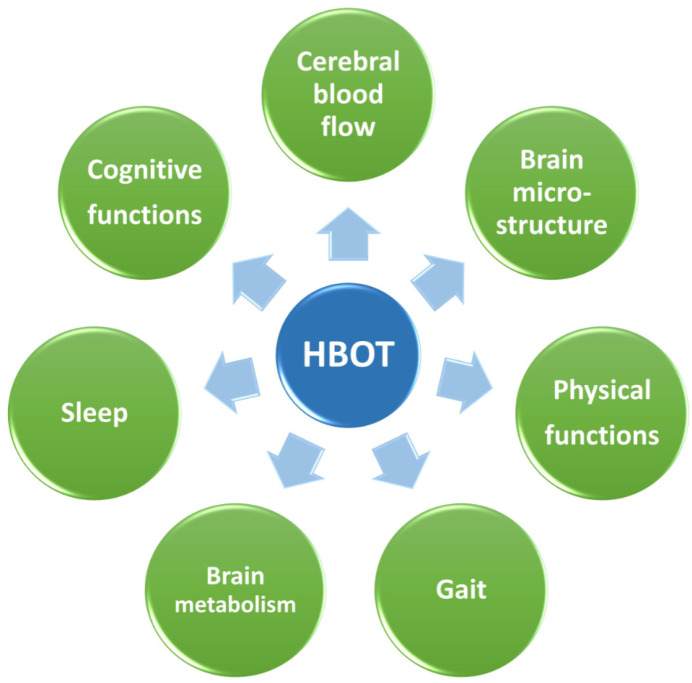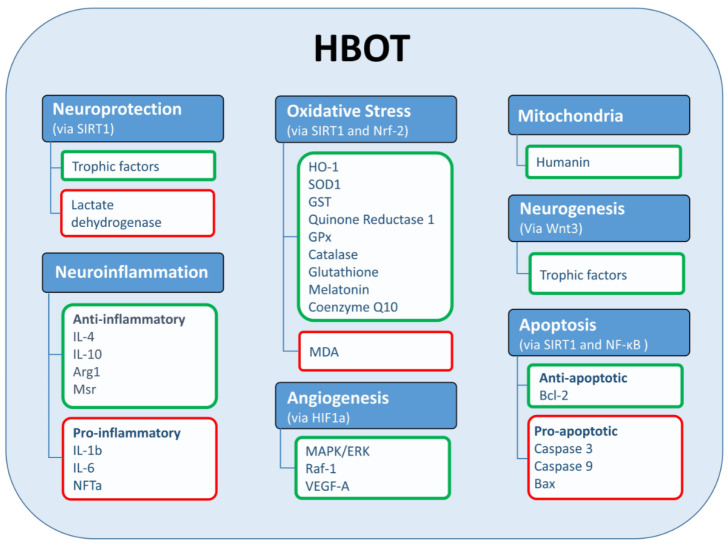The Mechanisms of Hyperbaric Oxygen Therapy for Cognitive Improvement
Abstract
Hyperbaric oxygen therapy is making significant progress in the medical landscape. Hyperbaric oxygen therapy (HBOT) has been shown to be effective in a variety of medical situations, including carbon monoxide poisoning and smoke inhalation injuries, as well as incurable diseases and radiation-induced wound healing. Recent studies also indicate that HBOT can improve neurological health outcomes and quality of life following brain trauma and stroke. Through pressurized oxygen administration, HBOT has shown promise as an effective, non-invasive therapy for patients suffering from various ailments. While more research is necessary to fully understand its limitations and efficacy for a range of illnesses, the ability of HBOT to provide positive results with minimal risk makes it an attractive therapeutic option for many patients. HBOT is a significant player in 21st century studies because of its ability to rehabilitate people through this unique form of oxygen therapy, potentially revolutionizing medical treatments as we know them.
Introduction
Hyperbaric oxygen therapy (HBOT) is a technique used in clinical practice with increasing prevalence. HBOT operates on the fundamental concept of administering 100% oxygen to patients at environmental pressures higher than the normal atmospheric pressure, which is a key factor in providing additional oxygen to body tissues and plasma. This medicinal effect allows up to tenfold more oxygen supply into affected areas, frequently sustaining impaired or defective vascular function, which is common after a stroke or brain injury. Its success is an audible testament that health improvements through increased oxygenation are a viable therapeutic option worth pursuing. [1 , 2]
In recent years, the medical community has been keen to explore the potential provided by hyperbaric oxygen therapy (HBOT) for treating an expanding list of illnesses. Clinical trials are ongoing and investigating a growing range of conditions, reflecting the versatility and capability of HBOT technology. Alongside these clinical trials, a further expansion of knowledge concerning the mechanisms underlying the efficacy of HBOT is also necessary. With promising signs of how HBOT can be applied to benefit other medical issues, it looks like the potential applications for this therapy will only continue to expand.
Hyperbaric Oxygen Therapy for:
1.1 Cognitive Improvement Following Brain Injuries
Hyperbaric oxygen therapy (HBOT) is a promising option for those dealing with a variety of brain-related issues. Despite pending FDA approval, numerous studies have highlighted various outcomes, such as improved cognitive functioning following the treatment, suggesting vast potential for treating some of society’s most challenging health conditions.
For example, post-stroke patients typically experience a decline in cognitive performance, including memory deficits. HBOT for stroke survivors in the later stages of chronicity showed remarkable improvements in all aspects of memory function, according to studies. This further resulted from the stimulation of brain metabolism; in particular, improvements were noted in the temporal regions. Separately, oxygen alone (given at 92%) was found to have a beneficial effect on an individual’s working memory who had intellectual and developmental disabilities—at least in the short term. [3]
For instance, traumatic brain injuries can have varying long-term consequences, some of which may not be immediately evident. Studies have indicated that hyperbaric oxygen therapy (HBOT) may be useful in improving the blood flow to the hippocampus in those with mild traumatic brain injury (TBI).
1.1 Cognitive Improvement Following AD and VD
Hyperbaric oxygen therapy can be an effective alternative for those with mild cognitive impairment (MCI), Alzheimer’s disease (AD), and vascular dementia (VD). Recent human studies have revealed its potential to improve memory functions in patients with these conditions.
For instance, a larger group of VD patients who received 12 weeks of HBOT at 2 atmosphere absolute demonstrated improvements in Mini-Mental State Examination (MMSE) scores and increased serum humanin levels [4]. As the current clinical application of HBOT is considered safe and well-tolerated, it should be taken into consideration for patients suffering from AD and VD as an alternative therapeutic approach [5].
Hyperbaric oxygen therapy (HBOT) is a rapidly evolving treatment in the healthcare community, and studies have found that it can potentially improve several aspects of brain activity. For instance, HBOT has been frequently used to increase cerebral blood flow, boost brain metabolism, and support brain microstructure. In turn, these benefits have improved cognitive and physical functions like sleep regulation and gait performance. Altogether, this leads to increased overall performance for individuals using this cutting-edge therapy.

Image Courtesy: NCBI
1.3 Cognitive Improvement Following a Healthy Lifestyle
The potential benefits of hyperbaric oxygen therapy (HBOT) on cognitive performance in young and elderly populations have been the subject of numerous studies. Early research looking into the effects of HBOT on elderly people [6] with cognitive deficits revealed a marked improvement in their cognitive function. Subsequent research involving a group of healthy young adults found that HBOT could not only enhance spatial working memory and memory quotient but also correlate with changes in regional homogeneity as measured by resting-state functional MRI [7]. These results indicate an encouraging role for HBOT in promoting cognitive performance across different age groups.
HBO therapy has proven to improve cognitive performance and provide a higher oxygen concentration than is typically available at higher atmospheric pressure. This elevated oxygen level directly contributes to the stimulation of brain activity, suggesting oxygen may act as an essential component in cognitive function [8].
While hyperbaric oxygen therapy can help improve physical well-being with just one use, it is far more effective when repeated and administered regularly. Long-term altercations can be observed in vascular, neuronal, and cellular activities, indicating the potentially promising therapeutic effects of regular HBOT treatments.

Image Courtesy: NCBI
2. HBOT Mechanisms for Cognitive Improvement
The “normobaric oxygen paradox” or “hyperoxic–hypoxic paradox” could be an influential factor in the efficacy of hyperbaric oxygen therapy (HBOT) [9 , 10]. During each HBOT session, the oxygen level is increased to as much as 100% or even less in some cases. Then it gets lowered back to 21% once the treatment has finished.
This fluctuating saturation of oxygen appears to activate several biological factors, such as the nuclear factor erythroid 2-related factor 2 (Nrf-2) being stimulated through the heightened amounts of oxygen and Hypoxia-Inducible Factor 1-alpha (HIF1a) when the amount falls back to 21% [11 , 12]. Thus, these fluctuations between higher and lower oxygen levels appear to be forces prompting restorative actions within the body.
2.1 HBOT for Neurogenesis
The introduction of hyperbaric oxygen therapy (HBOT) as a potential remedy for traumatic brain injury (TBI) drew an interesting study to evaluate the mechanism associated with its effectiveness. The results found that HBOT increases the proliferation and migration of neuronal stem cells. It also elevates the presence of vascular endothelial growth factor (VEGF), its receptor, VEGFR-2, Raf-1, mitogen-activated protein kinase (MEK1/2), and phospho-extracellular signal-regulated kinase (ERK 1/2) proteins in the lesion area [13].
Recent findings indicate that hyperbaric oxygen therapy (HBOT) improves blood flow in an Alzheimer’s disease (AD) mouse model [14]. Exploring HBOT’s effects on neurogenesis and angiogenesis could benefit many patients. Understanding this mechanism could result in significant advancements in the comprehension of HBOT’s effects and enable the use of this therapeutic option for a variety of neurological diseases. [15].
2.2 HBOT for Mitochondria
Hyperbaric oxygen therapy (HBOT) is a method of treatment used to enhance tissue oxygen levels to aid in the healing of some chronic wounds and conditions. Hyperbaric oxygen therapy (HBOT) is emerging as a potential therapeutic intervention for neurological disorders such as Alzheimer’s disease (AD). More specifically, it seems likely that the mitochondrion is a major molecular target of HBOT, given that mitochondria consume roughly 85 to 90% of all the oxygen we breathe. They are also the major source of adenosine triphosphate production. Recent research has uncovered promising findings on the effects of HBOT in rat models for AD. Here it induced distinct changes in mitochondrial-mediated apoptotic signaling by increasing Bcl-2, an anti-apoptotic protein, and decreasing Bcl-2 associated X protein (Bax), which is a pro-apoptotic factor [16]. While further studies are still needed to assess the efficacy and safety of this therapy, the indications from these studies provide grounds for optimism about its potential to treat a wide range of neurological conditions in humans.
Conclusion
Hyperbaric oxygen therapy (HBOT) has been used for ages to treat a wide range of conditions, and in modern times, evidence supports its ability to benefit those with neurological disorders. As such, HBOT is becoming increasingly important as an element of holistic healthcare; its positive influence can be seen in both the individual’s performance and the overall improvement of cognition. As forward-looking individuals become more conscious about preventive treatments, HBOT is likely to become a significant part of 21st century healthcare. These benefits have been shown to improve the system.





